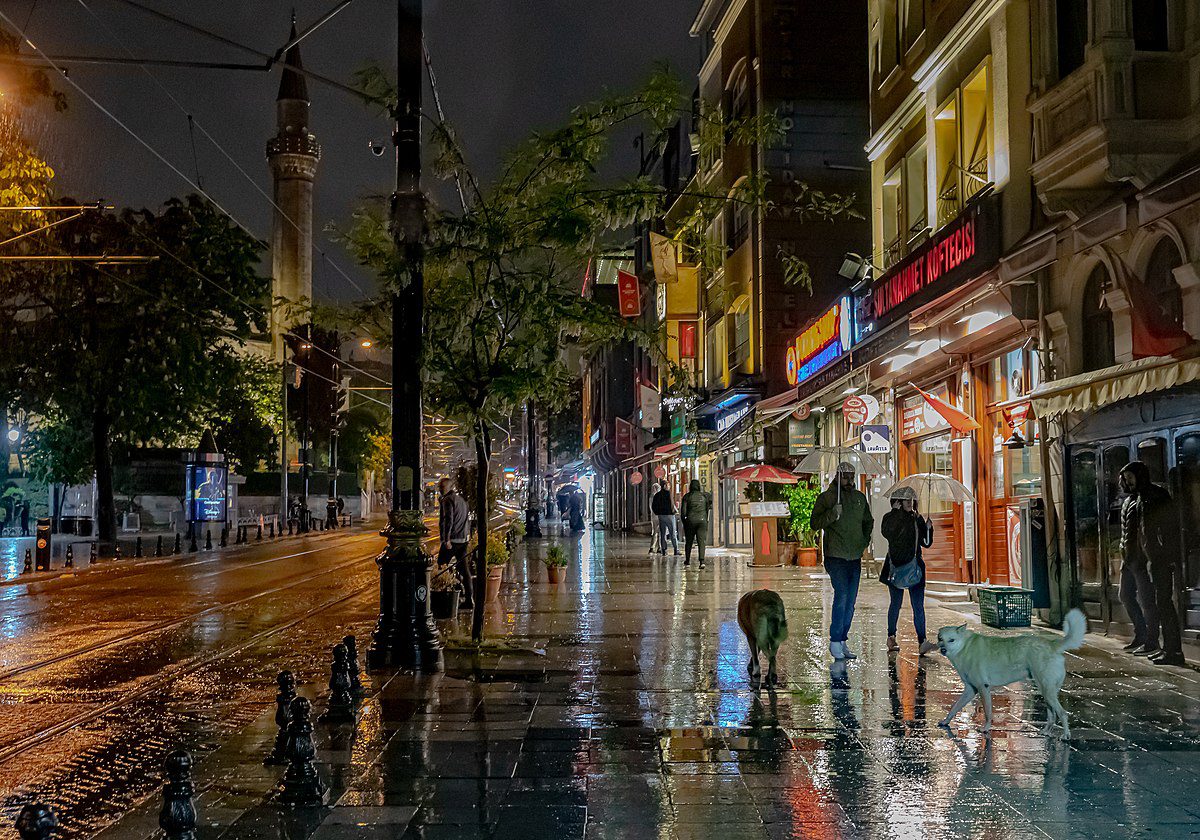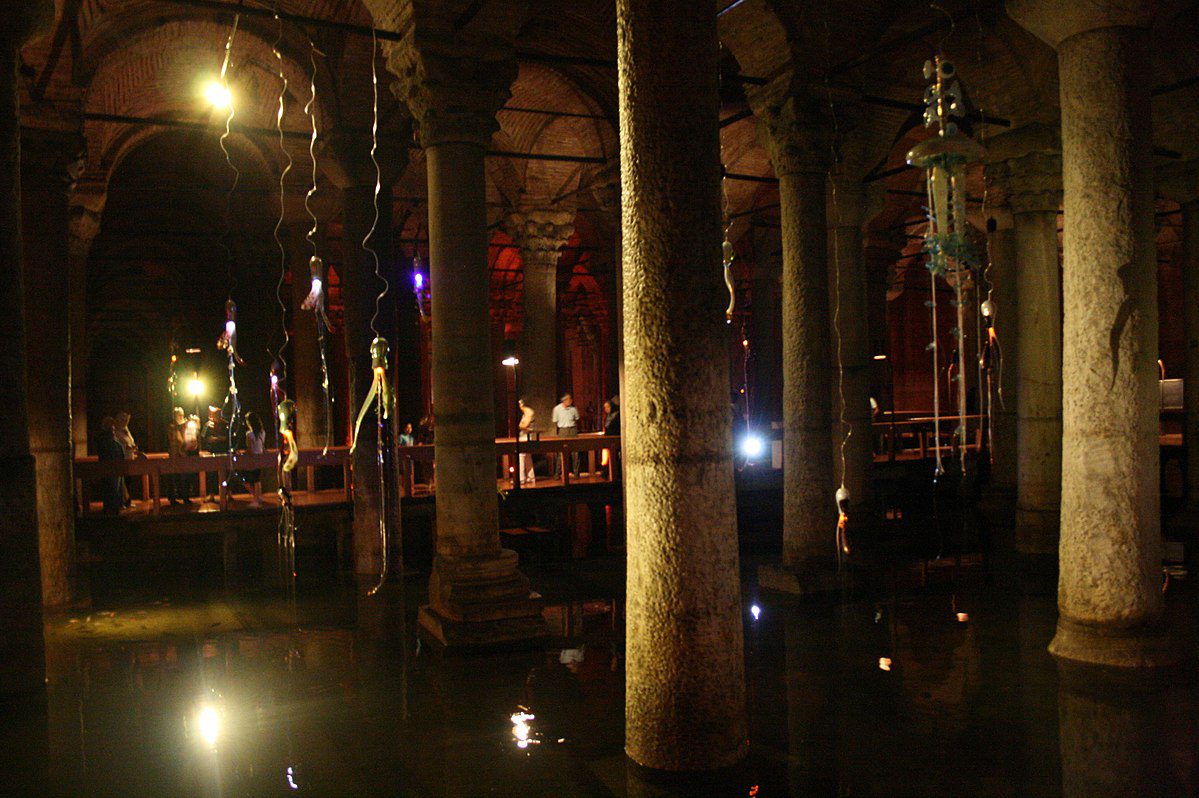Basilica Cistern. Photo by Taco325i. Wikimedia Commons
Top 10 Remarkable Facts about Basilica Cistern
Basilica Cistern is a subterranean wonder and one of the greatest and biggest surviving Byzantine antiquity sites in Istanbul.
Even though Basilica Cistern is simply a former water storage chamber, it seems like a flooded palace due to its imposing columns, grand scale and mysterious ambience.
Measuring approximately 453 feet by 212 feet, the cistern was initially built by Emperor Constantine and it was enlarged by the Byzantine Emperor Justinian I around 532 AD.
The cistern supplied the Grand Palace as well as the city of Byzantium with water. It has a capacity of holding around 80,000 cubic meters of water.
The cistern is located 150 meters southwest of Hagia Sophia on the historical peninsula of Sarayburnu in Turkey.
The square under which it is located was known as Stoa Basilica and on it stood a basilica hence the name of Basilica Cistern.
The top 10 remarkable facts about Basilica Cistern include the following.
1. Basilica Cistern Receives More Than 2.2 Million Visitors Annually

Sultanahmet Square. Photo by Ninara. Wikimedia Commons
Basilica Cistern also referred to as the “Sunken Cistern” is one of main tourist attractions in Sultanahmet –Istanbul. The cistern attracts over 2.2 million international tourists every year.
Sultanahmet is one of the most beautiful areas in Istanbul with many tourist attraction sites as it combines history, culture, architecture and art in one place.
The cistdern is one of the magical land marks in Turkey with a great history and stories to tell.
2. Basilica Cistern Looks Like an Underground Palace

Basilica Cistern. Photo by Dmgultekin. Wikimedia Commons
The Basilica Cistern looks like an underground palace due to the many Roman columns in the tank. The Turks call it Yerpatan Saray which means underground palace due to its magnificent features.
The cistern consists of imposing columns and its grand scale gives it a mysterious ambience.
The cistern measures approximately 453 feet by 212 feet and with a potential to hold 80,000 cubic meters of water.
The cistern treads its raised platforms to view 336 marble columns which are engraved together with vaulted ceilings.
3. Basilica Cistern Is Between 1500 To 1700 Years Old

Mosaic of Justinian I. Photo by Petar Milošević. Wikimedia Commons
One legend holds that the cistern was built by Emperor Constantine during 324 to 330 BC. During that time Emperor Constantine decided to construct a new city just like Rome on the legendary seven hills in Constantinople.
However, some historians hold that it was expanded in the 6th century when Emperor Justinian I in 53 A.D decided to enlarge the Basilica Cistern after the Nika revolution.
The Basilica Cistern is one of the oldest historical heritage of the Byzantine era. Along with Hagia Sophia and Hagia Irene, the cistern is estimated to be between 1500 to 1700 years old.
4. The Cistern Was Built as A Water Storage Tank

Emperor Constantine. Photo by Jean-Pol GRANDMONT . Wikimedia Commons
When the city of Constantinople was built by Emperor Constantine and Emperor Justinian I. it faced serious water shortage.
The emperors built many other cisterns such the philoxenus cistern, the Cistern of goodwill, and the cistern under the Nakash Centre.
All the cisterns were built as water storage tanks to supply the Grand Palace and city residents with water in case of a siege and solve the water problem in Constantinople at the time.
5. Basilica Cistern Is an Archaeological Wonder
To support the small domes above them, the cistern contains some 336 columns each about 9 meters in height.
The columns with an estimated length of 140 meters and a width of 70 meters seem endless to the naked eye. Distance between each column is 4.80 meters thereby making the cistern an architectural wonder.
The columns seem to have been brought from different ancient cities which had been destroyed as they are different from each other.
6. Basilica Cistern Can Hold About 80,000 Cubic Meters of Water
The Basilica Cistern contains about 336 columns each with a height of 9 meters each supporting small domes. The columns which have a length of 140 meters have a width of 70 meters as well.
The cistern covers an area of about 9,800 square meters and it can hold sufficient water to meet water need for months as it can hold over 80,000 liters of water.
The cistern was fed with water from the surrounding water sources and forests. However, water pipes that were used have long been removed.
7. Visitors Need to Plan Their Visit Meticulously
During summer, Basilica Cistern is usually very crowded as that is when many tourists are received at the cistern.
To enjoy their experience, visitors need to plan their visit carefully. Visitors need to get to the site early in the morning to avoid crowding.
There are cafes and souvenir shops located at the exit of the cistern.
Tourists can buy food stuffs, snacks, beverages and souvenirs from the cafes and shops to enable them remember the experience.
8. The Cistern Was Used as A Location for Several Movies
The cistern was the location for the James Bond movie From Russia with Love which was shot in 1963. In the movie the cistern is located under the Soviet consulate while in real life the location of the cistern is far away from the former Soviet consulate.
In the 2019 movie titled The International , the cistern is depicted as lying beneath the Sultan Ahmed Mosque which in the movie is directly adjacent to the Süleymaniye Mosque .
The cistern is also featured in the 2011 video game Assassin’s Creed: Revelations in which the player-controlled character Ezio Auditore is given a chance to explore the cistern.
The cistern is also featured in the 2013 Jean-Baptiste Andrea’s film thriller Brotherhood of Tears and the Dan Brown novel Inferno in 2013
9. The Cistern Was Initially Abandoned and Used as A Dumping Site
Designed to serve the Great Palace and surrounding buildings, the cistern was abandoned when the Byzantine Emperors relocated.
A scholar who was researching Byzantine antiquities rediscovered the palace in 1545.
However, after it was rediscovered the Ottoman rulers didn’t renovate it and it started being used as a dumping site for corpses and all sorts of junk from the city.
10. The Cistern Was Opened to The Public In 1987
The Istanbul Metropolitan Authority cleaned and renovated the cistern for two years as from 1985 to 1987.
As from 1987, when it was opened to the public, to the current period, the cistern has become one of the most popular tourist attractions in Istanbul.
Tourists walking along its raised wooden platforms feel water dripping from the vaulted ceiling and see schools of ghostly carp fish patrolling the water which gives a mysterious ambience.
Planning a trip to Paris ? Get ready !
These are Amazon’s best-selling travel products that you may need for coming to Paris.
Bookstore
- The best travel book : Rick Steves – Paris 2023 – Learn more here
- Fodor’s Paris 2024 – Learn more here
Travel Gear
- Venture Pal Lightweight Backpack – Learn more here
- Samsonite Winfield 2 28″ Luggage – Learn more here
- Swig Savvy’s Stainless Steel Insulated Water Bottle – Learn more here
Check Amazon’s best-seller list for the most popular travel accessories. We sometimes read this list just to find out what new travel products people are buying.









